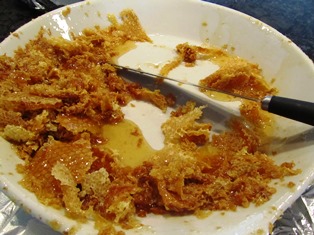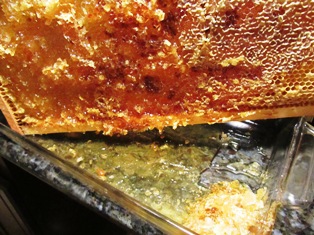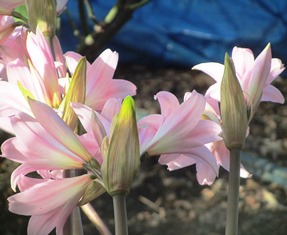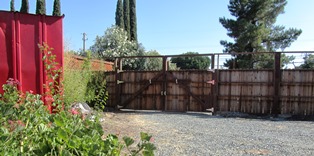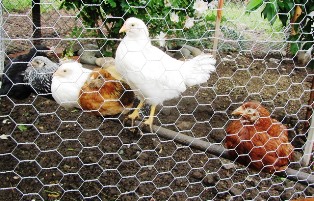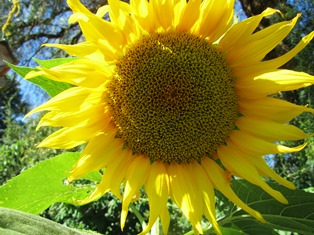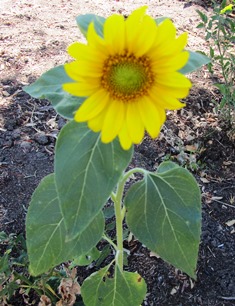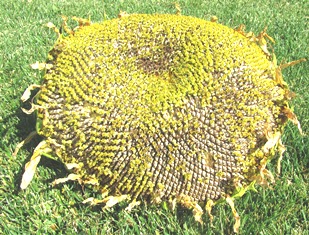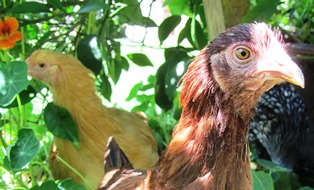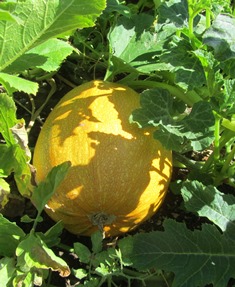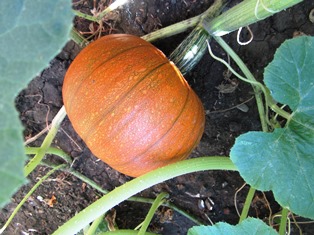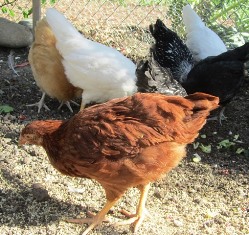Archive for July, 2014
Harvesting Honey the Old-Fashioned Way
Last weekend, my beekeeper neighbor and I harvested three frames of honey from my hives. I took the frames into my house and, with a hot knife, cut open the wax cells to permit the honey to drain.
I drained off one-half gallon of honey from two frames.

Two frames drain simultaneously in a five-gallon bucket; another option is to use large, flat plastic tubs
I wrapped the extra frame in foil and froze it until I am ready to drain that frame as well. Then, I will let it thaw for 24 hours before draining off the honey.
Once all the honey is out of the frames, I take the frames outside and hang them in the tree near the hives. The honeybees will do the cleanup, foraging all the honey and leaving only clean wax that I can melt for candle- or soap-making projects.
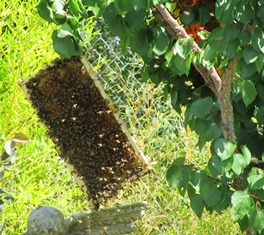
A frame of wax and residual honey is hung in a tree so the bees can clean it, hopefully before the ants find it
Draining honey from frames is a lengthy process and I have to do it twice: once to remove the honey and the second time to strain out any tiny particles of wax, before bottling it.
Last time, I took 20 frames and my neighbor, who was harvesting too, ran those 20 frames through his motorized extractor in his honey room.
Extractors are a modern convenience that saves untold hours extracting honey. But until I begin to sell my honey and other farm products, I won’t be able to afford such an energy-efficient tool.
I’ve discovered that beekeeping can be quite the expensive hobby. There are uncapping tubs, melters, comb cutting pans, heated knives, thermal plastic shrink bands for jars, uncapping needle rollers, and myriad other items used in honey extraction.
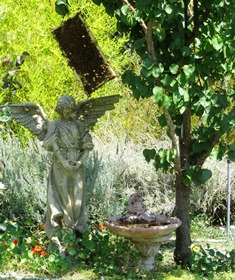
The tree near the hives holds two frames and a strainer of wax/honey from the uncapping of the cells that I also drained
Radial extractors can save time and preserves the honeycomb. The frames are placed between the guides of the stainless steel tank and the reel spins. The centrifugal force created throws honey against the sides of the tank. Honey is drained off through spigot. For now, the old-fashioned way works fine, too.
Little Foxes on my Front Porch
The heat drove me from bed this morning around 6 a.m. Northern California is in the midst of a triple-digit heat wave and there’s not much relief at night.
I made coffee, as I always do as soon after rising, and peeked out the back sliding glass door. I can see into the chicken house because my husband installed windows. The chickens were still on the roost. I’d have time for a swallow or two of coffee.
Then I heard what sounded like a knock at the front door. Padding across the living room in bare feet, I opened it, half expecting to see my daughter (also an early riser; she likes making runs to Starbucks for her coffee).
It wasn’t my daughter. It was a small fox. The poor thing seemed as startled to see me as I was to see it.
When the fox bounded off the porch, I saw the other two. Yes, there were three–a whole family–in my front yard. Perhaps they came down from the hills of Mount Diablo to search for water or food . . . so back to the chickens I went.
Certain that there was no way for the foxes to get into the chicken run, I let the hens out; gave them food and water. Then, after searching the property for those little foxes, I went back to enjoy my coffee while the sun rose to begin roasting the Bay Area.
The Four-Year Wait for a Bloom
Surprise isn’t the right word for what I felt rounding the corner today. I looked over into our rose garden and the bulbs we planted four years ago finally bloomed, sans the foliage which dried in the California heat a month or two ago.
These beautiful lilies were such a surprise. We saw the long stalks shooting upward with unopened buds on the end and wondered what they were. Then they opened to reveal these dazzling lilies.
They were likely planted in the 1950s or a decade later on the property adjacent to ours. The old man who owned the property behind ours passed away a year or so before we arrived. His daughter gave us the lily bulbs. Alas, she doesn’t seem to remember the flowers (except that there were bulbs) and we don’t know what kind they are either. They look like star lilies, and are born on 3 foot-stalks. There is a very sweet scent emitted from the center of the flower.
I’m having a devil of a time identifying them. There are so many types of lilies, including calla lilies, trumpet lilies, oriental lilies, and day lilies, to name a few. So if you know which cultivar they belong to, please email me at Meeralester1@Gmail.com.
Building an Expensive Estate Fence for Next to Nothing
Over the last week, my husband build an eight-foot-tall estate fence across the front of our property. When I wasn’t writing or doing other chores, I helped. We’re big believers in recycling, so naturally, when it came to the fence, we found a way to build it without cutting down a single new tree and use lumber that might otherwise go into landfill.
The idea for the fence is to have something beautiful and functional. We now have a fence next to the street and an interior fence. Between the two fences is a spacious half circular driveway where our cars and trucks can enter, leave, or park.

The new fence is 110 feet long with two gates, one opens for cars and the opens to the curved stone walkway
We were given some 6-by 6 posts (about 70 of them) by a friend working in demolition. A lot of useable pressure treated lumber came in the same delivery. We had saved fence boards we bought four years ago and, in an unbelievable stroke of luck, we had enough to cover the entire fence except for the very last 16-board section.

The wooden gate swings wide open to permit a vehicle or heavy machinery access (I’m thinking a boat would be nice)
Our plan is to add trellises on top of each fence section and install large wrought iron gates that will open electronically. For now, we just have an opening at one end of the fence for our curved stone path leading to the front door. The wooden gate at the far end of the fence will permit a truck or car to enter the back of the property.
By stacking the 6-by-6 boards on top of each other and drilling them together in place, Carlos made what amounts to planter boxes for the bamboo that line the property.
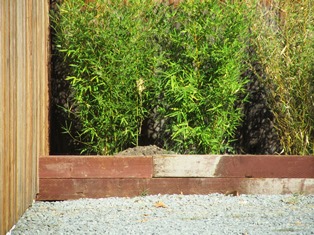
Stacked 6-by-6-foot lumber holds bamboo. Although one board needs staining, we don’t complain because the lumber was free
Gunshot Triggers Howls and Cackles in the Hood
Farm life isn’t always quiet. Night before last, a shot rang out around 11:00 p.m. It happened after some people in the neighborhood had engaged in a running argument, lasting hours.
My husband and I heard the arguing during our romantic dinner on the patio. His birthday is tomorrow and we celebrate birthdays all week, you see.
Hubby said he knew the sound of gunshots when he heard them. He was even more certain he’d heard the words, “We got to get out of here!” I was tempted to dive under the bed because people on the run with guns . . . well, that could be dangerous.
In the dark, you don’t know what has happened. I write mysteries. I’m thinking, “is there a body on the adjacent property?”
Three uniformed police officers arrive with nightsticks in their duty belts and guns in their holsters. With their flashlights drawn and turned on, they searched for a way into fortress that the neighbor has built or a means to see behind the tarps the neighbor has strung to hide his backyard and sheds.
Over the barking of the neighbor’s pit bull, I heard one officer tell the others, “This is like the Beverly Hillbillies. We’re notifying Code Enforcement.”
Glad it wasn’t our place they were talking about. We’ve been renovating . . . but neatly. Still, there’s the unfinished porch, the pile of lumber . . . .
I watched the erratic beams of their flashlights as they searched. Then . . . here they come, lights bobbing, down our driveway. They want to see if they can penetrate the fortress of the Beverly Hillbillies from another direction. Our house is in close proximity.
My husband went searching for a ladder. Call me silly, but I thought it would be the tall, thin officer, who would climb up. No, that would be too logical. It was the short, chunky one scaling into the heights, disappearing into the elm tree. Did I mention the tree has an almost impenetrable canopy in summer? Not surprising that he couldn’t see anything.
The officers decided on a look-see from the rear. My hubby guided them through a field, past the apiary and chicken house.
Roosting chickens are usually quiet. No doubt, you’ve heard the expression, “Going to bed with the chickens, rising with the rooster.” To say my hens were alarmed might be an understatement. They’d been roused from their slumber and cackled like there was no tomorrow. I realize there’s a bit of irony in the fact that our place is called the Henny Penny Farmette after Chicken Little’s story about the acorn falling on her head. This could have been the sky falling. They cackled like it was.
The deafening cackles agitated the neighbor’s pit bull, whose incessant barking got all the dogs in the hood howling. A fire engine shot by, sirens blaring. I took an aspirin, waited for my husband to return and the officers to leave.
Back in bed, who could sleep? I worried about when about when Code Enforcement might show up to cite the Beverly Hillbillies. Would the officers look over the fence and cite us as well? Code Enforcement aside, a gun-toter could hide behind our pile of porch lumber. We gotta get that porch finished.
But, like I said, it’s my husband’s birthday. He’s feeling romantic this week and not easily pushed. See my conundrum?
Get Ready for Blackberry Season
Southwest of the farmette lie the Santa Cruz mountains where blackberries grow wild. I know because I lived in those mountains and for many years hiked the environs of the mountain towns of Ben Lomond, Boulder Creek, Felton.
Nestle in the foothills, Los Gatos maintains Vasona Park where blackberries grow wild along the hiking/biking trail near a creek. I’ve been there several times this summer. Invariably, when I walk the trail in August or September and taste a ripe, freshly-picked blackberry, the sweetness and sprightly flavor evoke happy memories of summers past.
Our Henny Penny Farmette is located an hour and a half north of the Santa Cruz Mountains. Here we are situated in the shadow of Mount Diablo, but we have the kind of climate blackberries love. What is lacking is ample water that the plants need to thrive.
Blackberries require a deep soil and here we have clay (which can suffocate the berries because of the lack of good drainage the roots need). But we’ve helped the berries along by aerating and amending the soil with nutrients and with ground corn cob, aged horse manure, and compost.
Our trailing blackberries grow supported on a trellis. Use a two-wire trellis to avoid bending the canes too severely and to enable intertwining of the canes.
Last year, we planted a few of the semi-erect thornless berry vines. The Evergreen and Thornless Evergreen are commercial varieties and are extremely productive. The berries are large, black, firm, and sweet, pretty much perfect for eating out of your hand or using in a cobbler or pie. You can also make jam with blackberries alone or in combination with other fruits.
Some varieties can be so prodigious and hardy, adapting to the wild, that they are considered in some states and counties as noxious weeds, or pests. One species is the Himalaya cultivar. Its berries are shiny, black, about 1-inch long and the vines produce fruit with medium to large seeds. It quickly spreads and is difficult to control and eradicate.
The season for ripened blackberries is still a few weeks away, but watch for vines in the wild or plant some in your garden. Fall to spring is the best time for planting most berries.
Check with your local garden center for the right time to plant in your garden zone. Blackberries are perennial so the roots survive for many years, especially if the soil is loamy, well drained, and located in full sun to partial shade. For more information, see http://www.weeksberry.com/berryfiles/files/Blackberry.pdf.
The Wait Is Over–Gifts in the Chickens’ Nesting Boxes
Since March 7, the day I brought home eight baby chicks (The White Leghorns and the Silver Laced Wyandottes are two sets of sisters), I’ve been waiting for eggs. Today, I cleaned out the hen house and noticed that instead of three wooden eggs (I put them in the nesting boxes to encourage the hens to lay), there were five.
That means that either one of my White Leghorns laid two eggs or, more likely, each of them made a little deposit in the nesting box.
It’s a cheap thrill, I know, but I thought the egg-laying would start at 16 weeks but, in fact, it took 17 weeks and five days. Now, all that waiting seems almost silly. Hens lay when their DNA and biology tells them to. That’s all there is to it.
It remains to be seen if they will lay an egg each day or if their schedule will be more erratic. I’m not complaining since it’s nice to have fresh eggs any day I find them.
Sunflowers-A Source of Beauty and Food
Sunflowers have inspired human expression for centuries. The Incas made the sunflower a symbol of their god. In Europe, sunflowers symbolized kingship and were cultivated in gardens, at least until the 18th Century when they fell out of favor. The artist Vincent Van Gogh immortalized these sun-facing flowers in his paintings that bear witness to the hot summers he spent in Arles.
In fact, nothing symbolizes summer like the sunny faces of sunflowers. That image of beauty is a widely used motif in garden art and home goods. Freshly cut sunflowers in a jar, vase, or tin can brighten any room in which they are placed.
Native Americans ate the seeds or ground them for use in breads and cakes and used the dyes for body paint and clothing. Today the seeds are dried and roasted or sold as natural. The oil is pressed and used in cooking. Sunflower seeds are high in protein and are considered a healthy snack.
Even children can plant and tend sunflowers; they are easy to grow. The giant cultivars require ample garden space but planted in a circle or square, they can become a living fort that children enjoy playing under. Sunflowers are heavy feeders, so amending the soil with compost and manure will benefit their growth cycle. The plants are not particular about soil type but they do need regular watering.
Sunflowers can bear a single head, containing petals and seeds, or several heads on a single stalk. They range in size from small to giant stalks of twenty feet or more. Giant heads grow as much as two feet across.
Depending on the cultivar, the centers of these lovely flowers range from dark brown or black, or gray and white striped. The seeds are a favorite food of squirrels and birds and honeybees. Here on our farmette, we grow sunflowers near the apiary along with lavender. High-value food sources keep the bees around to pollinate the rest of our garden. And I can’t resist putting a few small heads in a jar to brighten my kitchen window.
Butternut Squash and French Sugar Pumpkins Takes Over the Garden
My organic vegetable garden is a mess of vines. Among the varieties of heirloom tomatoes, Armenian cucumber, summer squash, and eggplant that I planted in late spring, I also tucked in my favorite Butternut squash and French sugar pumpkins. The vines, although producing prolifically, have taken over. I can hardly get in to pick the tomatoes and I can’t see my chickens for the vines.
Next year, I’m going to try Bush Buttercup from Baker Creek Heirloom Seeds. The squash has the same orange flesh and firm rind but grows on bushy plants that say compact and grow between three and four feet high. The fruits weigh three to four pounds.
And maybe, with permission of my neighbor who has a large growing area adjoining our property I might plant Boston Marrow (first documented in 1831). That orange-fleshed squash can weigh up to 15 pounds. A native American tribe distributed the seed to settlers in New York and from there, the seed went to gardens in Massachusetts and spread elsewhere.
Another squash from that Baker Creek Seeds that I’d like to growl is Iran. Collected in Torbat-e-Heydariyeh, Iran in 1940 and preserved at the United States Department of Agriculture since, this is one of the loveliest of the ornamental squash. Orange color mottles its sea-foam green rind.
The pumpkins in my garden are Rouge Vif D’Etampes. I grew these with great success last year and saved the seed of this old French heirloom. A variety of seed companies carry this seed, including Baker Creek Seeds that notes it was one of the “most common pumpkins in the Central Market in Paris in the 1880’s . . . can be picked small and fried.”I like this one especially for pie making.
Squash and pumpkins taste great in Italian, Mexican, French, Middle Eastern, and American recipes. Rich in flavor and nutrients, squash and pumpkins can be made into soups, breads, mixed-vegetable dishes, and pies or can be baked, boiled, steamed, or fried. Even the blossoms are edible. So, it should be apparent why I need more room in my garden. Now to figure out how to keep it orderly.
You Can’t Hurry a Chicken into Laying an Egg
I brought home my little flock of baby chicks on March 7. Yesterday marked 16 weeks or four months. That’s important because that’s when the feed store told me I could start expecting eggs from my White Leghorns. Not with mine. They are taking their own sweet time.
The Rhode Island Red can take between 20 and 26 weeks–or so I’ve been told–to start laying. Mine just wants to forage in the yard, follow me around, get in my face, and eat any extra blueberries that I didn’t consume with my morning yogurt and honey. I had a talk with her yesterday about how I’m expecting some eggs in return for all those blueberries.
My flock also includes a Buff Orpington, a Black Sex Link, an Ameraucana, and two Silver Laced Wyandottes, the latter is an old heritage breed can take up to 32 weeks to begin laying. So maybe around Halloween, I’ll find their first offerings.
In anticipation of the big egg-laying event, I’ve switched the chicken food to a crumble for laying hens. Tomorrow I will buy some oyster shell calcium for strong egg shells. I’ve also tucked smooth, wooden eggs into their nesting boxes with some soft straw, hoping to encourage the girls to get with it.
Their voices have now changed from the peep, peep, to cluck, cluck. But I’ve yet to hear that loud cackle that tells me an egg has been laid. Sometimes I’ll see one of some serious squatting and get excited. Okay, this is it. But so far, it isn’t.
So the watch goes on. You can’t hurry a chicken who isn’t ready to produce eggs. So in the meantime, I’ll be eating a lot more yogurt and berries for breakfast.
 Facebook
Facebook Goodreads
Goodreads LinkedIn
LinkedIn Meera Lester
Meera Lester Twitter
Twitter






